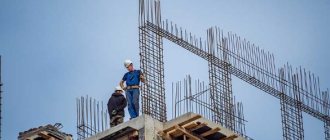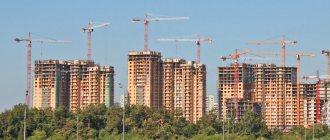Before receiving the keys to the apartment from the developer, the buyer must carefully inspect the premises and record all defects and defects. In order not to miss anything, you need to prepare in advance, be sure to take with you measuring instruments and things necessary for the inspection, as well as passport and agreement on participation in shared construction (DDU).
The inspection of the apartment begins with the local area and entrance. Regardless of what type of repair is specified in the contract (with or without finishing), the apartment must be checked for entrance doors, windows, walls and ceilings, the quality of the floor finishing, as well as the availability of electricity, water supply and ventilation. If any defects are detected, the developer is obliged to eliminate them within 45 days .
The developer's obligations to the buyer are considered fulfilled from the moment the acceptance certificate is signed. It details which apartment is being transferred to the buyer, the details of the purchase and sale agreement, as well as the condition of the property at the time of signing the deed.
The document cannot be signed until the builders eliminate all significant deficiencies or the developer agrees with the buyer on financial compensation for expenses.
General procedure and acceptance rules
By the time the transfer and acceptance certificate is signed, the apartment building (MKD) must be put into operation and have a postal address. The Technical Inventory Bureau (BTI) must measure all premises and issue technical passports to the developer, indicating the square area of each specific apartment.
Afterwards the process of acceptance of apartments by buyers begins:
- The developer notifies shareholders of its readiness to hand over the property. He can do this by telephone or send a notification by registered mail. Usually the developer informs about the completion of construction 2 months before handing over the keys.
- Within 7 days after receiving a notification from the construction organization, the shareholder must confirm his intention to accept the apartment - sign up for acceptance .
- If the buyer does not respond to the invitation or refuses acceptance for more than 2 months , the developer has the right to sign the acceptance certificate unilaterally (Clause 6, Article 8 of Federal Law No. 214 of December 30, 2014).
As a general rule, acceptance of a new apartment is carried out in two stages :
- On the appointed day, buyers meet with the developer at his office to check the documents .
All future owners come to the meeting; each of them must have a passport with them, as well as an equity participation agreement (DPA). It is needed for the developer to make sure that citizens have rights to the apartment. If it is not the buyer himself who participates in the acceptance, but his representative, he must present to the developer a notarized power of attorney confirming his authority. Sometimes, at a meeting with buyers, the developer immediately offers to sign the transfer and acceptance certificate without inspecting the apartment to save time - this is absolutely forbidden . In this case, the shareholder risks correcting the shortcomings at his own expense. - Future owners inspect the apartment , accompanied by a representative of the construction company, for any deficiencies. If there are no complaints, the parties sign a transfer and acceptance certificate .
Procedure for accepting an apartment
It is important to know how to correctly accept an apartment in a new building according to the transfer and acceptance certificate, otherwise problems cannot be avoided. The cooperation between the developer company and the client is coming to an end, the result of which is an act - the most important document that is necessary for registering an apartment. Before receiving this document, all work must already be completed in the building, it must have a postal address and be put into operation and accepted by the state commission.
Having received all the necessary documentation, the client receives an inspection sheet, inspects the apartment, indicates all defects on the sheet and signs the report. No more than six months pass from the moment the state commission accepts the house, but if the process drags on, it is necessary to consult with a lawyer. This behavior of the developer may confirm the most serious fears.
What to take with you to the apartment reception
Before you go for acceptance, you need to carefully read the contract with the developer and the project documentation again. These two documents must contain all technical information about the apartment, as well as about the local area, entrance and staircases. The buyer can also take his DDU with him to check the square footage, apartment plan and location of interior partitions.
To identify defects and record them for filing a claim, the buyer can take with him for inspection :
- pen and notepad for notes;
- flashlight;
- lighter or matches;
- chalk to mark imperfections;
- a small electrical device (for example, a phone charger) or a voltmeter will be needed to check the sockets;
- a building level and a vertical plumb line are needed to check the surface of the walls;
- You will need a tape measure to measure footage.
Defects discovered during the inspection must be described in a notebook and photographed. In the future, this data will be required to draw up a defect report.
If the buyer doubts that he will be able to determine all the technical shortcomings of the apartment on his own, he can turn to an expert for help . There are construction companies specializing in providing such services, whose employees have all the necessary knowledge and have the appropriate equipment to identify shortcomings when inspecting premises.
Necessary tools when accepting an apartment
Often, when accepting an apartment in a new building, the customer completely forgets that it is necessary to subject not only his home, but the entire house to inspection. After all, basement or attic spaces constructed in violation of building codes will ultimately affect the comfort of all residents. Apartments are usually inspected in daylight, because lighting devices in a new house are not installed immediately.
In any case, you should go to the meeting armed with a solid set of tools:
- flashlight;
- lighter or matches;
- voltage tester;
- building level;
- plumb line;
- ladder;
- bulb;
- electrical appliances of various capacities;
- voltmeter;
- notepad and fountain pen.
However, all these tools are not able to provide a 100% guarantee. Therefore, if some aspects cause concern, then there is no shame in inviting a professional from an independent expert company.
Acceptance of an apartment in a new building
It is best to make an appointment in the morning or afternoon. In the evening, in an unfinished apartment, it is difficult to notice even the most obvious defect.
The inspection begins in the common areas . At least one elevator must be working in each entrance at the time of delivery of the apartment building. If the apartment is located on the ground floor, you need to ask the developer to show the basement. You can also ask to inspect the technical floor and find out about the condition of the roof. The buyer has the right to make claims to the developer for poor quality finishing of entrances, staircases, mailboxes, etc.
What repairs should be made to the apartment and what is included in it is described in the DDU . Depending on the terms of the agreement and the developer’s operating principles, new houses are usually delivered either with finishing or without (rough renovation).
How to accept an apartment in a new building without finishing from the developer
Renting an apartment without finishing usually means that the work on the construction of walls and cladding of the facade has been completed in the premises. No other renovation work was carried out in the apartment . The buyer will see in the apartment only concrete walls, ceilings and floors, as well as places for connecting electrical wiring and water supply.
- Entrance door . Rubber seals should be installed along the contour of the door frame. This is necessary to ensure that heat does not escape from the apartment. Then you need to inspect the mounting seams, check whether all the keys fit, and how smoothly the door opens and closes.
- Windows and balcony .
You need to inspect each window, its glazing, and also check the window sills and bevels. The handles should not wobble or bend. Checking for a draft is quite simple - you just need to hold a lighter to the joint between the frame and the window. If the flame deviates, the seal is broken. - Walls . Upon acceptance, it is necessary to examine all joints and check for the absence of cracks and bumps. The curvature of the walls should be no more than 5mm. for every two meters .
- Ceilings . In each room it is necessary to check the height of the ceilings and compare it with that stated in the contract. The joints in the ceiling must also be sealed. The permissible ceiling deviation is up to 0.01 mm .
- Floors . In apartments with a rough finish, there should be a concrete screed on the floor. You need to knock on it to make sure that nothing is being pressed anywhere, the sound is the same in different places when knocking, and there are no voids in the floor. If there is a gap of more than 5mm between the floor surface and the wall. - this is considered a defect that must be reported to the developer.
- Electrics . You need to carefully examine the panel, and also write down the meter readings in the acceptance certificate. All switches must be labeled. The presence of electricity must be checked at each outlet. To do this, you can use a phone charger or a small electrical appliance. The sockets can be checked by screwing a light bulb into them. All wires must be connected to switches, and hooks for attaching chandeliers must be installed in the ceiling.
- Heating . The radiator must hang at a distance of at least 60 mm. from the floor and 50 mm. from the wall . All pipe connections must be welded. You can tug on the battery to assess the reliability of the mount. Then you need to check the operation of the heat regulator and the presence of a shut-off valve.
- Sewerage and water supply .
First you need to inspect the risers, pipes and drains, check their verticality and method of fastening. The shut-off valves on the risers should be free of rust. You also need to inspect the meters and write off their readings. The bathtub and toilet must have a sewer tee that connects the drain pipes from the sink, toilet and bathtub. If it is located too low, problems with plumbing installation may occur. - Ventilation . You can check whether the ventilation is working in the following way: open the window and place a sheet of paper on the ventilation grille. If it does not fall, the system is set up correctly.
- Square area . The calculation of the area must be carried out together with the apartment plan from the DDU. The length and width of the walls are measured at floor level. If the size of the apartment is smaller than stated, compensation can be demanded from the developer.
How to accept an apartment in a new building with finishing from the developer
As a rule, an apartment with a fine finish is already completely ready for occupancy . The repair has already been completed and the buyer just needs to check its quality.
- Walls . The wallpaper must be glued evenly. There should be no flaws under the radiators, at the junction of walls or baseboards. Additionally, you need to measure the curvature of the walls, and also make sure there are no leaks on the ceilings.
- Flooring . Tiles, laminate or linoleum should not creak or sag anywhere, and the finishing parts should fit snugly together.
- Interior and entrance doors . Structures must be installed correctly, without scratches or cracks. You need to check how they open and close. Handles and locks should work properly.
- Communications . All sockets, meters, ventilation, plumbing and other equipment must be carefully installed and in good condition.
Features of receiving an apartment with different types of finishing
Before you find out how to accept an apartment in a new building with finishing, you need to find out what finishing options are available in general. There are 3 types:
- Rough finishing involves the presence of entrance doors, double-glazed windows, installation of sewerage and water supply systems, electricity supply, installation of water and electricity meters.
- Pre-finishing means that the apartment is ready for final finishing work. The walls of such apartments are plastered, the floors are finished with screed, water supply, sewerage and heating systems are equipped, all sockets and lamps work. Such apartments already have entrance doors, glazed windows, and balconies.
- Finishing "turnkey" implies the possibility of immediate occupancy of residents.
Rough and pre-finishing
Most buyers strive to purchase housing with a pre-finished finish. When purchasing a home with a rough finish, you just need to make sure that the equipment matches that described in the contract. But when buying an apartment with pre-finishing, you must definitely pay attention to the quality of the plaster (1), the quality of the concrete screed (2), the quality of the glazing (3) and the condition of the engineering systems (4):
- With high-quality plastering of walls and ceilings, there should be no cracks, peelings, or traces of tools on the surface. The surfaces of the walls and ceiling should be almost perfectly smooth, only minor deviations within 1-2 mm are allowed.
- The deviation limits of the concrete screed vary depending on the future floor covering: - for laminate or linoleum, deviations within 2 mm are permissible; — for tiling, deviations within 6 millimeters are permissible; — the deviation of the floor from the horizontal should not be higher than 2%, but not more than 50 millimeters, regardless of the dimensions of the room.
- All windows and doors made of metal-plastic must be easy to open, and the glass itself, window sills and other surfaces must not have cracks, chips, scratches or other damage. Window sills in the apartment should not interfere with the spread of heat from radiators.
- The heating system should ideally be equipped with Mayevsky taps for air release, as well as temperature regulators. When installing radiators, the following parameters are observed: - distance from the floor - at least 6 cm; — from the window sill to the top edge of the radiator — 5 cm; — from the wall to the radiator — 25 mm.
Turnkey finishing
In most cases, when accepting an apartment with an exclusive turnkey finish, no problems arise, since all the details of cooperation are discussed in detail in advance. But even in an apartment with a turnkey finish, the results of builders’ errors can often be observed, so everything should be checked carefully.
Certificate of acceptance and transfer of an apartment in a new building
The act of accepting an apartment in a new building is an official document, despite the fact that it is drawn up in simple written form . The document makes it possible to influence the developer and demand compensation from him in case of improper fulfillment of the terms of the contract.
All citizens indicated in the share participation agreement must sign the act.
The transfer and acceptance certificate must contain :
- postal address of the house;
- housing costs;
- apartment dimensions;
- names of the parties;
- cost of housing.
Transfer and acceptance certificate: sample 2020 ()
Before signing the deed, the buyer must re-read it carefully. After the document is signed, the developer’s obligations to the shareholder will be considered fulfilled , and the management company will begin to charge fees for maintaining the apartment.
What documents do you need to take with you to inspect your new apartment?
In order to sign the acceptance certificate for an apartment in a new building, you will need:
- original of the share participation agreement with the developer,
- project documentation with an apartment plan,
- copying the results of measurements of residential premises made by BTI,
- the acceptance certificate, previously sent by the developer by mail or given to you on the spot,
- passport.
In some situations, inspection and acceptance may be carried out without an acceptance certificate. Then write down all the shortcomings that you are not happy with in the apartment on paper and give it to the developer for signature.
At the time of inspection and acceptance of the apartment, your house must already be accepted by the state commission.
How long does it take to transfer an apartment?
Such information is recorded in the DDU. This document indicates the exact date of acceptance and transfer of the house to the future owner. Don't adapt to the developer. He can get an approved permit at the very last moment. This does not mean that the customer should rush along with him and sign the acceptance certificate in a hurry. The customer will need time to inspect the home and make a decision.
What are the shortcomings that prevent the transfer and acceptance certificate from being signed?
All detected deficiencies are recorded in the inspection sheet (defect report). The document is drawn up in free form, in two copies - one for the buyer, the other for the developer. The act must indicate the details of the buyer and the construction company. The main part of the document indicates the shortcomings, and at the bottom the date of verification and signatures of the parties are indicated.
As a general rule, defects are divided into two types:
- Significant defects are those that make it impossible to live in the apartment. For example, holes in walls and windows, non-functioning sewage systems, incorrectly installed entrance doors. The buyer must sign the acceptance certificate only after the developer has eliminated such deficiencies.
- Minor shortcomings do not interfere with life in the apartment. These include: uneven walls, scratches on glass, etc. They also need to be recorded. If the buyer refuses to sign the deed due to minor defects, the developer has the right to sign the document unilaterally after 2 months . Such a document can only be challenged in court.
View sheet ()
If the buyer finds deficiencies, he has two options :
- Do not sign the act . The buyer has the right to demand that defects be eliminated and the inspection be repeated. With this option, the developer will have to hurry in order to deliver the apartment by the deadline.
- Sign a document with the condition that the deficiencies be eliminated . If the developer cannot eliminate any defects, he can negotiate financial compensation with the buyer.
Builders have 45 days (Article 20 of Law No. 2300-1 of 02/07/1992). Afterwards, the developer invites the buyer for a second inspection. If the shareholder is satisfied with everything, he can sign the deed.
In addition to eliminating defects, the buyer has the right to demand compensation from the developer for the costs of eliminating defects or reducing the contract price (Clause 2, Article 7 of Law No. 214). Only after the parties come to an agreement can the acceptance certificate be signed. Afterwards, the owner will receive the keys to the apartment and will be able to contact Rosreestr to register ownership.
Question
Warranty period
I bought an apartment in a new building. Due to the rush during acceptance, I missed several defects. Can I demand compensation from the developer or is it too late?






